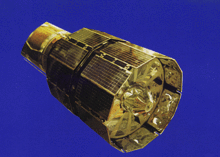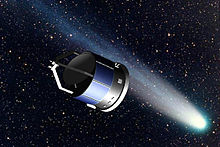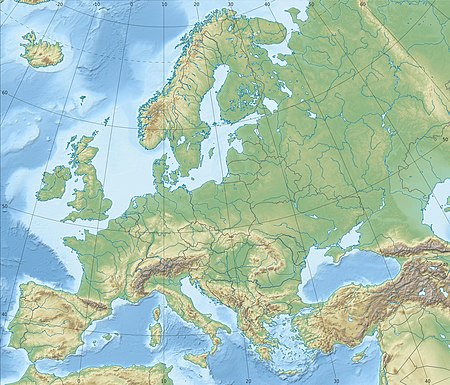European Space Agency
![]()
ESA is a redirect to this article. For other meanings, see ESA (disambiguation).
The European Space Agency (ESA) (French: Agence spatiale européenne (ASE) ![]() ), based in Paris, was founded in 1975 to better coordinate European space activities and to be on an equal technological footing with the space-faring nations of the Soviet Union and the United States, rather than being completely technologically and politically dependent. It has 22 member states and employed about 2,300 people in 2019.
), based in Paris, was founded in 1975 to better coordinate European space activities and to be on an equal technological footing with the space-faring nations of the Soviet Union and the United States, rather than being completely technologically and politically dependent. It has 22 member states and employed about 2,300 people in 2019.
ESA is the successor organisation to the European ELDO, ESRO and the European Telecommunications Satellites Conference (CETS). Like the latter, it limits its European space exploration and exploitation projects to "exclusively peaceful purposes".
ESA is not a sub-organisation of the EU, but is closely interlinked with the EU and the national space agencies of its member states through numerous cooperations. The majority of EU countries participate in ESA, but Switzerland, Norway and the United Kingdom are also involved.
Together with NASA, ESA is a founding member of the Consultative Committee for Space Data Systems (CCSDS).
The Director General of ESA has been Josef Aschbacher since 1 March 2021.
History
The foundation
After World War II, many European aerospace engineers and scientists left Western Europe to work in either the United States or the Soviet Union. Although the boom of the 1950s allowed Western European countries to invest in research and spaceflight, European scientists realized that national projects could not compete with the two superpowers. As early as 1958, just a few months after the Sputnik shock, Edoardo Amaldi and Pierre Auger, two prominent members of the Western European scientific community, met to discuss the creation of a joint Western European Space Agency. The meeting was attended by scientific representatives from eight countries.
The Western European nations decided to create two separate agencies: ELDO (European Launcher Development Organisation) was to develop and build launchers and ESRO (European Space Research Organisation) was to develop the scientific satellites. ESRO was established on 20 March 1964 by an agreement signed on 14 June 1962. Between 1968 and 1972, ESRO celebrated its first successes: seven research satellites were launched into orbit using American launchers. ELDO, on the other hand, was unable to launch a successful launcher during its existence. Both organisations were underfunded and the separation into two organisations did not prove successful.
The ESA was founded on 30 May 1975 by the Convention on the Establishment of a European Space Agency with signature under the Agreement by the initially still ten original founding members in Paris as a merger of the ESRO with the ELDO. Following the deposit of the last instrument of ratification by France, the establishment then entered into force on 30 October 1980 in accordance with Article XXI(1) of the Convention.
The foundation aimed at a better coordination of European space activities in order to be able to act technologically on an equal footing with the space nations Soviet Union and United States. As was previously the case with ESRO, participation in the scientific programme is mandatory for all members of ESA, while participation in other programmes such as application satellites, launch vehicles or manned spaceflight is restricted to countries that are interested in them and wish to contribute to them. ESA awards contracts to the space companies of the countries participating in the programmes according to the membership contributions to the respective programmes.
The beginnings
In the early 1970s, when the competition for space between the United States and the Soviet Union had died down and the budgets of space agencies were being dramatically cut, ESA established itself as a pioneer in the peaceful exploration of space.
ESA launched its first major scientific mission in 1975 with the COS-B satellite. In cooperation with NASA and the British SERC, IUE was launched in 1978. It was the first space telescope in Earth orbit and operated until September 1996.
A large number of successful Earth-orbit projects followed, and in 1985 the first deep-space mission began with Giotto, which studied Halley's Comet in 1986 and the comet Grigg-Skjellerup in 1992. In the following period a large number of projects were launched, partly in cooperation with NASA, which are listed below. As the successor organisation to ELDO, ESA also successfully developed its launchers for commercial and scientific payloads under the Ariane programme during this period.
The recent history
At the beginning of the new millennium, ESA, together with space agencies such as NASA, ISRO, JAXA or Roskosmos, has become a major player in space research with projects such as the Hubble Space Telescope launched in 1990.
While in the 1980s and 1990s ESA still relied on cooperation with NASA, various circumstances (e.g. legal restrictions on the exchange of information, incalculable project cancellations due to sudden funding cuts) have led to newer missions increasingly being carried out by ESA itself or in cooperation with Roskosmos or JAXA, for example. Since 2002, ESA's own ESTRACK network no longer only has worldwide tracking stations for satellite tracking and for rocket launches, but also its own deep space stations for lunar missions, missions at the Lagrangian points and interplanetary space missions and the technology for rocket launches and for critical flight manoeuvres such as entering a lunar or planetary orbit. Overall, ESA is evolving into a strong organisation that, at its core, relies more and more on its own competencies and on pooling the achievements of Member States and the various national space agencies than on contributions from space agencies outside ESA.

ESA logo until 2019

ESRO-2B was the first successful satellite of ESRO in 1968.

Giotto with Halley
Locations
|
|
Main facilities
ESA is organised on a decentralised basis. Most of the current sites are still based on facilities of the predecessor organisations.
- ESA headquarters in Paris, France
- European Space Research and Technology Centre (ESTEC) in Noordwijk, the Netherlands
- European Space Security and Education Centre (ESEC) in Redu, Belgium
- European Space Operations Centre (ESOC) in Darmstadt
- European Astronaut Centre in Cologne, Germany
- Columbus Control Centre (Col-CC) and one of eleven ESA Business Incubation Centres (BIC) in Oberpfaffenhofen
- European Space Research Institute (ESRIN) in Frascati near Rome in Italy
- European Space Astronomy Centre (ESAC) in Villafranca del Castillo, Villanueva de la Cañada, near Madrid in Spain
- Guiana Space Centre in Kourou, French Guiana
- Esrange base for altitude and microgravity research near Kiruna, Sweden
ESA Business Incubation Centres
As of May 2020, the following ESA Business Incubation Centres existed, each with date of establishment:
- 2004: BIC Noordwijk, Netherlands
 Netherlands
Netherlands - 2005: BIC Lazio in Rome, Italy
 Italy
Italy - 2007: BIC Hessen & Baden-Württemberg in Darmstadt, Germany
 Germany
Germany - 2009: BIC Bavaria in Oberpfaffenhofen, Nuremberg and Berchtesgadener Land district, Germany
 Germany
Germany - 2011: BIC UK in Harwell, United Kingdom
 United Kingdom
United Kingdom - 2018: BIC Belgium in Redu, Geel and Mol, Belgium
.svg.png) Belgium; the BICs in Flanders and Wallonia, founded in 2012, merged to form BIC Belgium in 2018.
Belgium; the BICs in Flanders and Wallonia, founded in 2012, merged to form BIC Belgium in 2018. - 2013: BIC Sud France in Aquitaine, Midi-Pyrénées and Provence-Alpes-Côte d'Azur, France
 France
France - 2014: BIC Barcelona, Spain
 Spain
Spain - 2014: BIC Portugal with three locations, Portugal
 Portugal
Portugal - 2015: BIC Madrid Region, Spain
 Spain
Spain - 2015: BIC Sweden, Sweden Sweden

- 2016: BIC Czech Republic in Prague, Czech
 Republic Czech Republic
Republic Czech Republic - 2016: BIC Austria in Graz, Austria
 Austria
Austria - 2016: BIC Ireland, Ireland
 Ireland
Ireland - 2016: BIC Switzerland in Zurich, Switzerland
 Switzerland
Switzerland - 2017: BIC Estonia in Tallinn, Estonia Estonia

- 2017: BIC Finland, Finland
 Finland
Finland - 2018: BIC Nord France, France France

- 2018: BIC Hungary in Budapest, Hungary
 Hungary
Hungary - 2018: BIC Norway, Norway Norway

ESA also has offices in the USA, Moscow and Toulouse.
Questions and Answers
Q: What is the European Space Agency?
A: The European Space Agency (ESA) is an international organization with 22 member countries. Its job is to explore space and its headquarters are in Paris, France.
Q: How many staff members does ESA have?
A: ESA has a staff of more than 2,000 people.
Q: What is the annual budget of ESA?
A: The annual budget of ESA is about €4.43 billion / US$5.51 billion (2015).
Q: What countries are members of ESA?
A: The member countries of ESA are Austria, Belgium, Czech Republic, Denmark, Finland, France, Germany, Greece, Ireland, Italy, Luxembourg, the Netherlands, Norway Portugal Spain Sweden Switzerland and the United Kingdom.
Q: What activities does ESA's space flight programme include?
A: ESA's space flight programme includes human spaceflight; launch and operations of unmanned exploration missions to other planets and the Moon; Earth observation; running a major spaceport at Kourou French Guiana; designing launch vehicles.
Q: Who operates Ariane 5 launch vehicle?
A: Ariane 5 launch vehicle is operated through Arianespace with ESA sharing in the costs of launching and further developing this launch vehicle.
Search within the encyclopedia

